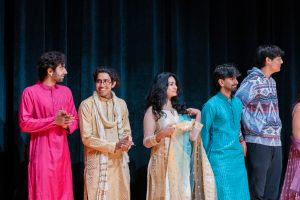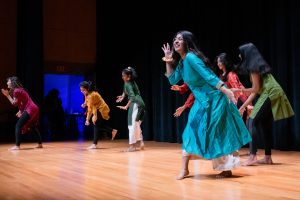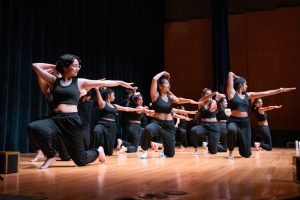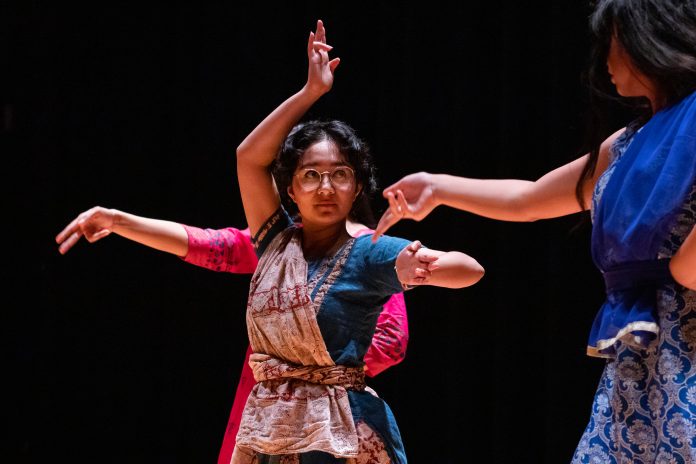A special aspect of the College of William and Mary is its ability to commemorate the different cultures that the campus encompasses. One of the integral organizations of this multicultural student body, known for its exciting events and celebrations, is the South Asian Student Association. SASA offers a place of community and representation to South Asian students looking for a space where they can express themselves and celebrate aspects of their individual cultures with each other and the rest of the student body.
Recently, the organization put on one of its famous celebratory events known as SASA Expressions. Serving as a three hour-long showcase of South Asian culture, the show premiered Feb. 25 in Sadler Center’s Commonwealth Auditorium. Tickets to the event priced at around $5 completely sold out.

The beginning of the showcase featured “Lassi Mouth,” a student-directed and student-written play showcasing the wide-ranging diversity in issues that different South Asians face and the importance of teaching the history of religious minorities during early education. Inspired by the Disney Channel original movie “Lemonade Mouth” with reference to the South Asian yogurt-based drink mango lassi, the play centered around a group of students — played by SASA members — training for a dance competition to earn money to fund a new educational curriculum that uplifted religious minorities.
After the skit, the event quickly switched tones. With a dramatic cut-off of the lights, the audience was no longer greeted with actors, but rather with an assortment of dancing, singing and instrumental performances.
The second part of the event opened with an emotional spoken word poetry set from Expressions Co-Director Meeran Khan ’25. He detailed to the audience his experience as a Muslim as well as the struggles he has endured with his South Asian identity. A similar act later followed, in which SASA President and Expressions co-host Adam Razaq ’23 performed an equally impactful spoken word poetry set. Throughout his performance, he relayed to the audience about the struggles for Muslims in how they are often blamed for actions taken by the minority extremists of their religion and the harmful propaganda surrounding Pakistanis in the media.

The showcase also introduced a dance competition between the different class year groups of the association. Dressed in colorful, traditional attire, the freshman dance group went first and danced with a happy energy and lots of movement. Throughout the dance, the audience cheered, energetically supporting the underclassmen.
“The preparation for the dances was intense yet wholeheartedly worth it,” SASA Treasurer Dev Saxena ’25 said. “We hired three Expressions directors, and their entire job was to lay out which performances we could perform.”

Performances from SASA sophomores, juniors and seniors were later interspersed throughout the rest of the show, equally matching the energy from the freshmen. In between these class-based dance groups, many other performances also took place, such as Bollywood-based dance performances by Afsana, as well as a high-energy, enthusiastic dance from the Punjab region of India by Griffin Bhangra. The two groups performed exciting and unique dance routines for the crowds that displayed the plethora of body movement styles of different South Asian cultures.
“A lot of the people in SASA have experience dancing,” Public Relations Chair Ranjani Krishnan ’25 said. “Whether that just be, casually and socially or, you know, traditional dancing. And so everybody just kind of volunteered. We had a lot of choreographers volunteer to put together mixes or choreograph dances.”

Something that was special about these dances was the music. Many of the performances were able to combine traditional South Asian music and dance with a modern beat consisting of musical references to pop culture. This allowed choreographers to integrate Charlie’s Angels, Drake and hip hop moves into the choreography. Despite the various ages and levels of expertise, the performers were able to piece together captivating acts that displayed the various talents of the organization’s members.
In addition, the showcase included several singing acts, performed by both male and female groups. One noteworthy performance, featuring Pooja Muthuraj ’26, consisted of stunning vocals, accompanied by an expert violin solo. SASA member Rayaan Anjarwalla ’24 stressed the importance of showcasing culturally-linked creative arts on campus.
“I think it was a great, great introduction for a lot of people into South Asian culture, a lot of dancing, singing, some amazing spoken word poetry,” Anjarwalla said.

The production ended with the SASA senior group dance, a heartwarming performance for those graduating from the College and leaving their SASA friends in the spring. After the hosts gave their closing remarks and expressed their gratitude for the SASA team and executive board, it was time for the audience to enjoy the final part of the event: the dinner.
After departing from Commonwealth Auditorium, guests were invited to go to Tidewater, where they were met with a delicious array of traditional Indian cuisine and desserts catered by Spice Palace. Lines for the food went all the way around the room in a spiral-like distribution.

“The dinner was great,” Krishnan said. “Everybody was just really excited to celebrate after all the performances went so well, and everybody was dressed up, and we all got to eat together and celebrate.”
SASA’s Culture Chair Hazel Vineet ’25 ultimately emphasized the importance of events like Expressions to the College community due to the space they provide students to express themselves and maintain a place of connection with their cultural identity.
“I think it’s really important to have events that uplift minority voices, especially the South Asian community,” Vineet said. “And it’s just really important to make sure people have events where they feel represented and seen.”

